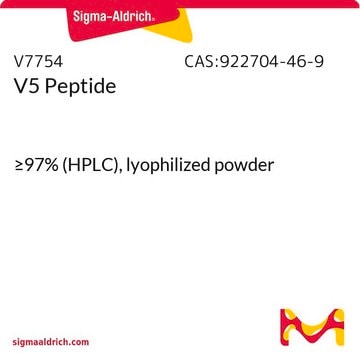I2149
Hemagglutinin Peptide
≥97% (HPLC), powder, Influenza
Synonym(s):
Anti-HA, HA tag peptide, HA1 fragment 98-106, Tyr-Pro-Tyr-Asp-Val-Pro-Asp-Tyr-Ala
About This Item
Recommended Products
product name
Influenza Hemagglutinin (HA) Peptide, ≥97% (HPLC)
biological source
synthetic
Quality Level
Assay
≥97% (HPLC)
form
powder
mol wt
1102.15 Da
technique(s)
protein extraction: suitable
storage temp.
−20°C
SMILES string
CC(C)[C@H](NC(=O)[C@H](CC(O)=O)NC(=O)[C@H](Cc1ccc(O)cc1)NC(=O)[C@@H]2CCCN2C(=O)[C@@H](N)Cc3ccc(O)cc3)C(=O)N4CCC[C@H]4C(=O)N[C@@H](CC(O)=O)C(=O)N[C@@H](Cc5ccc(O)cc5)C(=O)N[C@@H](C)C(O)=O
InChI
1S/C53H67N9O17/c1-27(2)44(52(77)62-21-5-7-41(62)50(75)59-38(25-42(66)67)47(72)56-36(45(70)55-28(3)53(78)79)23-30-10-16-33(64)17-11-30)60-48(73)39(26-43(68)69)57-46(71)37(24-31-12-18-34(65)19-13-31)58-49(74)40-6-4-20-61(40)51(76)35(54)22-29-8-14-32(63)15-9-29/h8-19,27-28,35-41,44,63-65H,4-7,20-26,54H2,1-3H3,(H,55,70)(H,56,72)(H,57,71)(H,58,74)(H,59,75)(H,60,73)(H,66,67)(H,68,69)(H,78,79)/t28-,35-,36-,37-,38-,39-,40-,41-,44-/m0/s1
InChI key
HVLSXIKZNLPZJJ-TXZCQADKSA-N
General description
Application
Preparation Note
Other Notes
Storage Class Code
11 - Combustible Solids
WGK
WGK 3
Flash Point(F)
Not applicable
Flash Point(C)
Not applicable
Personal Protective Equipment
Certificates of Analysis (COA)
Search for Certificates of Analysis (COA) by entering the products Lot/Batch Number. Lot and Batch Numbers can be found on a product’s label following the words ‘Lot’ or ‘Batch’.
Already Own This Product?
Find documentation for the products that you have recently purchased in the Document Library.
Customers Also Viewed
Our team of scientists has experience in all areas of research including Life Science, Material Science, Chemical Synthesis, Chromatography, Analytical and many others.
Contact Technical Service














